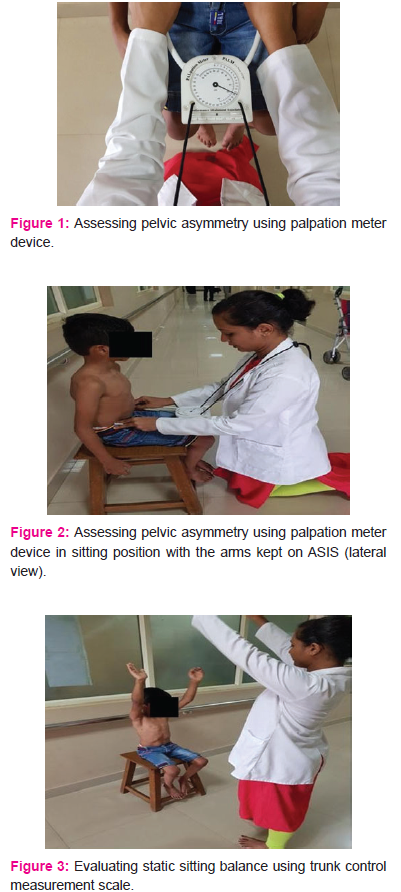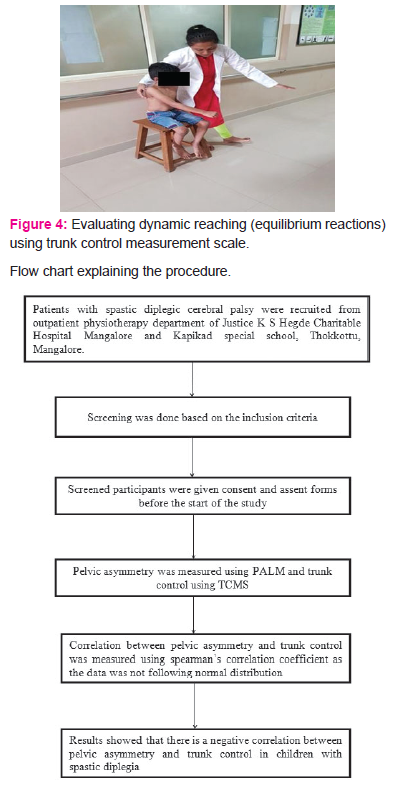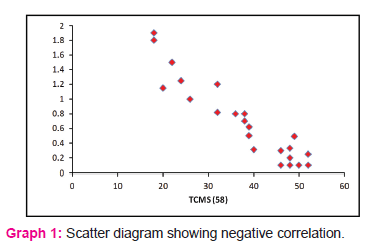IJCRR - 11(11), JUNE, 2019
Pages: 01-04
Date of Publication: 10-Jun-2019
Print Article
Download XML Download PDF
Correlation between Pelvic Alignment and Trunk Control in Children with Spastic Diplegia - A Cross-Sectional Study
Author: Feba Sara Oommen, Suchetha PS, Dhanesh Kumar KU
Category: Healthcare
Abstract:Aim: To evaluate the correlation between pelvic alignment and trunk control in children with spastic diplegia of the age group 8-15 years.
Methods/Design: The study used a cross-sectional research design. 24 children with spastic diplegic cerebral palsy were included in the study. Pelvic asymmetry of each child was measured using palpation meter device (PALM) and trunk control using a trunk control measurement scale (TCMS) on the same day with 5 minutes break in between.
Results: The results show that there is a negative correlation between pelvic asymmetry and trunk control. The p-value is < 0.001 which shows that the study is significant.
Conclusion: The study concludes that there is a negative correlation between pelvic asymmetry and trunk control in children with spastic diplegia.
Keywords: Pelvic alignment, Spastic diplegia, Trunk control
Full Text:
INTRODUCTION
Cerebral palsy (CP) defines a group of permanent disorders of the development of movement and posture causing activity limitations that are attributed to non- progressive disturbances that occurred in the developing fetal or infant brain[1].
Cerebral palsy is one of the commonest physical dysfunction that children face during their childhood. The prevalence of CP is 1.5 to 4 per 1000 live births of the age group 10 to 14 years. The overall birth prevalence of CP is 2 per 1000 live births[2].
Spastic diplegia is the predominant type of CP in preterm children, especially in the most immature preterm children[3]. Children with spastic diplegia demonstrate a normal tone or hypotonia in the first four months. Spasticity gradually develops and is then progressive in the leg during the initial stages of life[4].
Impaired trunk control, pelvic asymmetry, balance, and gait asymmetry are some of the common impairments in spastic diplegia[5, 6, 7].
Trunk control is defined as control of proximal muscles of the spine that stabilize the trunk when the body is responding to gravity, either in quiet balance patterns or during a movement or position change in space[8].
From retrieved works of literature, it is proved that pelvic asymmetry is a common impairment in CP [9]. Children with CP often show weakened trunk control, which can, in turn, affect their daily functional tasks including reaching, sitting and walking[10]. The pelvis acts as a base in the sitting position and as a connecting link between the trunk and lower limbs while standing.
It is assumed that pelvis and trunk are in close relation concerning impairment and association. But there is a scarcity of literature which shows the impact of the trunk on pelvis and pelvis on the trunk. If the correlation is proved between pelvic alignment and trunk control, the inclusion of pelvic training strategies in the early stages of rehabilitation of children with spastic diplegia will yield promising results.
As there is a dearth of literature that establishes correlation linking trunk control with pelvic malignment, this study is been taken up to establish a correlation between the two, using the outcome measures PALM and TCMS in children diagnosed as spastic diplegic CP of the age group 8-15 years.
METHODOLOGY
A total of 24 children with spastic diplegia were recruited from the out-patient physiotherapy department of Justice K S Hegde Charitable Hospital Mangalore and Kapikad special school, Thokkottu, Mangalore. Approval from the scientific committee and the Institutional Ethics Committee was obtained before the commencement of the study. All subjects were screened before participating in this study, using the following inclusion criteria: Either gender between 8-15 years of age, children diagnosed with spastic diplegia, children having pelvic asymmetry (measured by palpation meter device), children who are able to follow commands (paediatric mini-mental state examination), children who can sit independently at least for 15minutes, children with gross motor function classification system level between ?-???.
Children undertaking botox injection since 6months, who underwent surgery involving the spine and lower limbs in the past 6months, those having uncontrolled seizures since past 6months, those children with fixed deformities in the spine and with any fractures and dislocations of the spine and lower extremities were excluded from the study.
Before commencing the study, consent and assent forms were obtained. Pelvic asymmetry of each child was measured using palpation meter device and trunk control using a trunk control measurement scale on the same day. A break of 5 minutes was given between the two. Instructions were given to the children regarding the scale and device.
RESULTS
For this study, 24 children with spastic diplegia had been recruited. Of these, 70.8% were males and 29.2% were females.
Since the data is not following a normal distribution, Spearman‘s correlation coefficient was used to calculate the correlation between pelvic alignment and trunk control. The p-value less than 0.001 considered significant for the study. The trunk control measurement scale has a mean value of 38.04 + 11.58 and PALM has a mean value of 0.69 + 0.54.
The correlation coefficient is -0.918 and p-value is < 0.001, which shows that there is a negative correlation between pelvic asymmetry and trunk control in children with spastic diplegia as shown in the scatter diagram below.
DISCUSSION
The purpose of the current work was to inquire the correlation between pelvic asymmetry utilizing palpation meter device and trunk control using a trunk control measurement scale (TCMS) in children with spastic diplegia. It was a cross-sectional study and no intervention was given. 24 children diagnosed with spastic diplegia were included in the study.
Socio-demographic details revealed that 70.8% of the total sample included were males and 29.2% were females. Researches show that the occurrence of cerebral palsy is greater in males compared to females with a ratio of 1.33:1[11].
The results of the present study indicated that there is a correlation between pelvic asymmetry and trunk control in children with spastic diplegia. Non-parametric correlation test, Spearman‘s correlation was used, as the data was not following a normal distribution. The correlation coefficient is -0.918 and the p-value is <0.001 which shows that there is a negative correlation between pelvic asymmetry and trunk control and the study is significant. This leads to the rejection of the null hypothesis and acceptance of an alternate hypothesis.
A similar study was conducted by Shivani Pathak et al on stroke population and concluded that there is a negative correlation between pelvic tilt and trunk control in patients with stroke[12].
A cohort study was conducted to assess the occurrence of pelvic asymmetry and lower limb shortening in children of the age group 4-16 years. The study aimed to assess the changes in the prevalence of pelvic asymmetry and lower limb functional length in children and adolescents after 10 years. The study concluded that there is a significant reoccurrence of pelvic asymmetry in children after 10 years of observation (23.8% and 71.4% in boys, 22.4% and 46.5% in girls)[13]. When normal children have the chance of occurrence of pelvic asymmetry, children with cerebral palsy will be more prone to its occurrence.
A cross-sectional study was conducted by Panibatla S et al on the relationship between trunk control and balance in children with spastic cerebral palsy. 24 children of the age group 8-14 years with spastic cerebral palsy (Gross Motor Function Classification System level 1-3) were included in the study. The study concluded that there is a positive correlation between trunk control and balance in children with spastic cerebral palsy[14].
Ayse Yildiz et al conducted a study on the association of trunk control and upper extremity functions in children with cerebral palsy. Trunk control measurement scale was used to assess the trunk control and quality of upper extremity skills test for assessing upper extremity functions. The study showed that there is a significant positive correlation between trunk control and upper extremity functions in children with cerebral palsy[15].
Various researches are showing the association between trunk control and various other parameters like balance in children with cerebral palsy. The present study proves that there is a strong negative correlation between the asymmetry of pelvis and trunk control in children with cerebral palsy. Pelvic training strategies should be included in the regular rehabilitation measures of children with cerebral palsy to improve pelvic asymmetry which is a common problem faced by them. This, in turn, helps in improving the trunk control as proved in this study.
CONCLUSION
The results of the present study conclude that there is a strong negative correlation between pelvic asymmetry and trunk control in children with spastic diplegia of the age group 8-15 years. Pelvic symmetry has to be considered as an important component in the rehabilitation strategies of children with spastic diplegia that in turn helps in the improvement of trunk control.
LIMITATIONS OF THESTUDY
-
-
-
The sample size selected for the study was very small.
-
Only spastic cerebral palsy was included in the study.
-
The age group was limited to 8-15 years.
SCOPE FOR FUTUREWORK
-
-
-
Larger sample size can be considered for a better confirmation of the results.
-
Different types of cerebral palsy can be taken into account.
-
All cerebral palsy children who can sit independently can be included in the study irrespective of the age group.
-



References:
-
Rosenbaum P, Paneth N, Leviton A, Goldstein M, Bax M, Damiano D, et al. A report: the definition and classification of cerebral palsy April 2006. Dev Med Child Neurol Suppl. 2007;49:8-14.
-
Stavsky M, Mor O, Mastrolia SA, Greenbaum S, Than NG, Erez O. Cerebral Palsy—Trends in Epidemiology and Recent Development in Prenatal Mechanisms of Disease, Treatment, and Prevention. Front Pediatr. 2017;5:21.
-
Leppert M. Developmental-behavioral pediatrics. 4th ed. Philadelphia, Pa: Saunders/Elsevier; 2009.
-
Fenichel G. Clinical pediatric neurology. 6th ed. Philadelphia, Pa: Saunders/Elsevier; 2009.
-
Shepherd R. Physiotherapy in pediatrics. 3rd ed. London, Pa: Elsevier/Butterworth- Heinemann; 1995.
-
El Basatiny HM, Abdel aziem A. Effect of Trunk Exercises on Trunk control, Balance and Mobility Function in Children with Hemiparetic Cerebral Palsy. Int J Ther Rehabil. 2015; 4(5):236-43.
-
Niklasch M, Döderlein L, Klotz M, Braatz F, Wolf S, Dreher T. Asymmetric pelvic and hip rotation in children with bilateral cerebral palsy: Uni- or bilateral femoral derotation osteotomy?. Gait Posture. 2015; 41(2):670-5.
-
Umphred D. Neurological rehabilitation. 5th ed. Edinburgh, Pa: Elsevier/Mosby; 2006.
-
Niklasch M, Döderlein L, Klotz M, Braatz F, Wolf S, Dreher T. Asymmetric pelvic and hip rotation in children with bilateral cerebral palsy: Uni- or bilateral femoral derotation osteotomy?. Gait Posture. 2015; 41(2):670-5.
-
El Basatiny HM, Abdel aziem A. Effect of Trunk Exercises on Trunk control, Balance and Mobility Function in Children with Hemiparetic Cerebral Palsy. Int J Ther Rehabil. 2015; 4(5):236-43.
-
Agarwal A, Verma I. Cerebral palsy in children: An overview. J Clin Orthop Trauma. 2012; 3:77-81.
-
Pathak S, Vijaya Kumar K, Nayak A, Kedambadi RC. The relationship between pelvic alignment and trunk control in stroke subjects: a cross-sectional study. Int J Res Med Sci. 2014; 2(4):1483-7.
-
Kluszczynska A, Kluszczynski A, Raczkowski J, Siwik P. Evaluation of pelvic asymmetry and lower limb functional shortening in a cohort of children re-examined after a ten-year observation. Scoliosis. 2014; 9(1):01.
-
Panibatla S, Kumar V, Narayan A. Relationship between trunk control and balance in children with spastic cerebral palsy: a cross-sectional study. J Clin Diagn Res. 2017; 11(9):5-8.
-
Yildiz A, Yildiz R, Elbasan B. Trunk control in children with cerebral palsy and its association with upper extremity functions. J Dev Phys Disabil. 2018; 30(5):669-76.
Acknowledgments
My sincere and heartfelt gratitude to Mr. Kovela Rakesh Krishna, Associate Professor, Vikas College of Physiotherapy, Mangalore for his constant support and guidance throughout the study. I am very grateful for the support provided by Dr. Purusotham Chippala, Clinical in charge, Department of Physiotherapy, Justice KS Hegde Charitable Hospital, Deralakatte, Mangalore. My heartfelt gratitude to Dr. Sanal TS, Statistician, for his guidance in the statistical analysis of the study.
Ethical clearance obtained from Nitte (deemed to be University)
Ref: NIPT/IEC/Min//015/2017-18/dated 21-01-2018
Conflicts of interest: None
Funding: Nil
|






 This work is licensed under a Creative Commons Attribution-NonCommercial 4.0 International License
This work is licensed under a Creative Commons Attribution-NonCommercial 4.0 International License